Take a closer look at some of the weird and wonderful food and drink items in the museum’s collection. Researcher Dr Shirin Hirsch, Exhibitions Officer Mark Wilson and Visitor Experience Supervisor Bob Dinn have put together a serving of objects for you to savour in this long read.
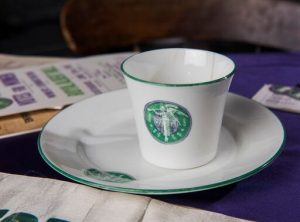
Suffragettes and tea were once quite a pair. Meetings were held in tearooms to discuss and plan at a time in the early 20th century when it was not a society norm for women to meet out of the home.
This particular tea set, carrying the Angel of Freedom design created by suffragette Sylvia Pankhurst (1882-1960), was made by H W Williamson in Stoke-on-Trent for the Women’s Social and Political Union (WSPU) who sold these to raise funds and support. The original owner, suffragette Rose Lamartine Yates (1875-1954), regularly held fundraising tea parties for the Wimbledon WSPU in the gardens of her home, Dorset Hall in Wimbledon. The Lamartine Yates family would have had multiple suffragette tea sets in their home during the height of the campaign for women’s suffrage.
The collection at PHM also holds small plates, teacups, saucers, sugar bowls, milk jugs and even teapots.
Where can you see this item or find out more?
On display in Main Gallery One. Read the blog about suffragette Rose Lamartine Yates (1875-1954) from Dr Alexandra Hughes-Johnson, suffrage historian and Women in the Humanities Research Co-ordinator at the University of Oxford.

The Crumpsall Biscuit factory opened in 1873 and was world famous for Jammie Dodgers and Custard Creams. It was also renowned as the first biscuit factory to have an eight hour day.
There were numerous facilities for the factory’s employees including a cricket club, football club, tennis courts, a bowling green, recreation ground and library. The works put on social events including sports days, dances and whist drives. There was a Sick Benefit Society, and girls however young were employed at a good wage to do specific work, not to save the expense of employing men.
Where can you see this item or find out more?
On display in Main Gallery Two. Also look out for the Sunderland Employees banner (1871) which was produced to celebrate a national agreement between employers and workers over the nine hour day. Take the ‘which radical are you?’ quiz to discover whether you are matched with Robert Lowes; grandfather of the modern weekend.
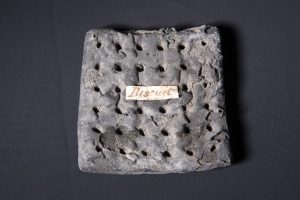
This biscuit might have gone past its sell by date, dating as it does from 1871, but it has seen more than a slice of history.
It is likely to have been made when the four month siege of Paris took place during the Franco-Prussian war (1870-1871), which preceded the Paris Commune. Some of the biscuits were kept as mementos to the suffering and resilience of the siege. Following the signing of an Armistice, the Paris Commune (think of the equivalent as being a borough in England) refused to accept the authority of the French government, and governed Paris independently for two months. The Paris Commune was a radical socialist and anti-religious government that was eventually suppressed by the French Army. Many were killed during what was known as ‘Bloody Week’, thousands were taken prisoner and tried (hundreds were sentenced to death, others to imprisonment or deportation), and thousands more still escaped to other countries in exile, including the UK. The army set fire to a lot of buildings and executed anyone they thought was connected with the commune politically.
As the biscuit is burnt, it has been suggested that it was made during the siege, kept as a memento, and then became a souvenir of the Paris Commune and the ‘Bloody Week’ that followed the war.
Where can you see this item or find out more?
This item is not currently on display, but you can visit the socialism section in the main galleries at PHM to find out more about this chapter of history.
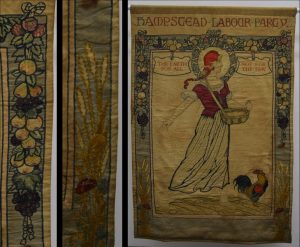
A wonderfully intricate object that shows a barefooted woman, walking across a ploughed field, sowing corn from a basket. The composition and style of this beautiful banner, which includes a border of fruit and bunches of corn, was influenced by the Arts and Crafts movement. Reacting to the dehumanising effects of industrialisation, this was established in 1887 to promote traditional artistic techniques and skills such as woodworking, embroidery and calligraphy. Its members looked back to an idealised medieval world of greater simplicity and the main figure on the banner clearly reflects this.
Where can you see this item or find out more?
Previously on display in the 2021 Banner Exhibition. Read a blog about the banner by PHM’s Bob Dinn From violent protest to attic safety, which reveals the banner’s last known political use on anti-Vietnam War protests outside the US Embassy in London in 1968.
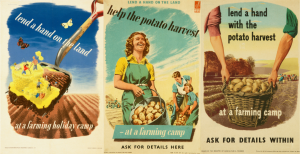
The Dig for Victory campaign by the Ministry of Information began during World War II. It produced some iconic advertising, including a campaign encouraging women to join the bid to produce more food with the promise of a free farm holiday. These feature the colourful work of the graphic designer Eileen Evans (above left poster). Over 200,000 women served in the Women’s Land Army between 1939 and 1950. As well as producing food they were involved in many other things, including rodent control to protect the crops – apparently two land girls killed 12,000 rats in 1944!
Where can you see these items?
See the posters on display in both Main Gallery One and Main Gallery Two.
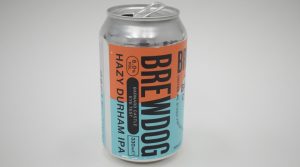
The Barnard Castle controversy took place at the peak of covid-19. The former Prime Minister’s chief advisor, Dominic Cummings, made a journey across the country with covid-19 symptoms during the first ‘lockdown’ in March 2020, when non-essential travel was forbidden. Brewdog came up with a tongue-in-cheek response with the production of this ‘hazy’ beer.
Where can you see this item or find out more?
Not currently on display. Read more about PHM’s new acquisitions.

This badge combines one of the world’s most iconic brand identities, Coca-Cola, with one of its biggest ever advertising slogans, it’s the real thing, which began in the 1970s and is still remembered today. But the history behind the badge itself remains something of a mystery – one that the PHM team are hoping to solve. If you can share any information, please get in touch with the Collections Team: collections@phm.org.uk.
Where can you see this item?
Not currently on display. Read more about PHM’s new acquisitions. Also part of the museum’s LGBT+ related collection is the Never Going Underground banner, which was carried at the infamous 1988 protest in Manchester against Section 28; the piece of legislation that forbade ‘the promotion of homosexuality’. The protest is powerfully represented by artist Kate Charlesworth whose illustration demonstrates the anger and solidarity of the 20,000 protesters and is available as a print from PHM shop.
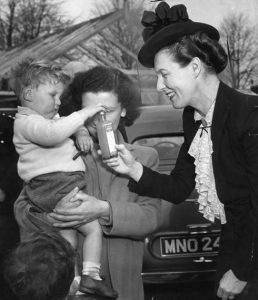
Britain after 1945 was an austere place, in which food continued to be rationed until 4 July 1954. As a result, undernourishment was a serious problem. One response to this issue was to introduce a range of vitamin loaded food supplements for children. Here we see Dr Edith Summerskill handing a child vitamin rich orange juice, visually encapsulating her post war priorities as a feminist and Labour Party minister.
Apart from concentrated orange juice, high in vitamin C, there was NHS bottled cod liver oil, and jars of malt syrup. The orange juice was held to be good for boils!
It was not just children for whom Summerskill worked. She was an ardent feminist, one who campaigned for women’s interests in 1950s Britain. She demanded better health care and diet, birth control advice for young, less privileged mothers, and wanted to alleviate the pressures on the mother in the ‘baby boom’ of post war Britain – Summerskill saw these as the first priority for many exhausted and anaemic working class mothers.
Where can you see this item?
Labour Party photographic collection, Labour History Archive & Study Centre at the museum. Book an appointment with our expert Archive Team to delve into PHM’s incredible collection of political archive material, which includes items of national importance documenting the growth of democracy in Britain.
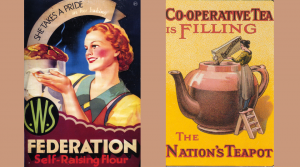
Co-operatives have been around in the UK since the 18th century, but really kicked off with the founding of the Rochdale Society of Equitable Pioneers (Rochdale Pioneers) in 1844. This became a prototype for the societies that followed with the adherence to principles of co-operation being something that co-ops around the world continue to follow to this day.
The basic idea was that people would band together, paying a small sum each week, and the Co-operative would then buy goods, which most working class people wouldn’t have been able to afford before, and sell them on. These smaller groups eventually merged into the Co-operative Group which then turned into the formation of the Co-operative Wholesale Society (CWS) in 1863. The CWS manufactured products as well as selling them – you can even see the old CWS tobacco factory on the train line from Manchester Victoria to York.
Where can you see this item or find out more?
CWS posters are on display in the replica Co-op shop in Main Gallery Two.
An earlier version of this blog was first published in September 2022.